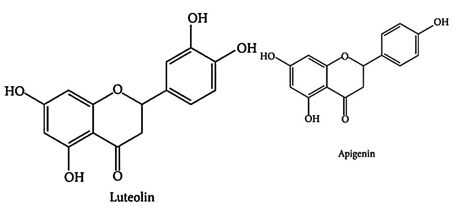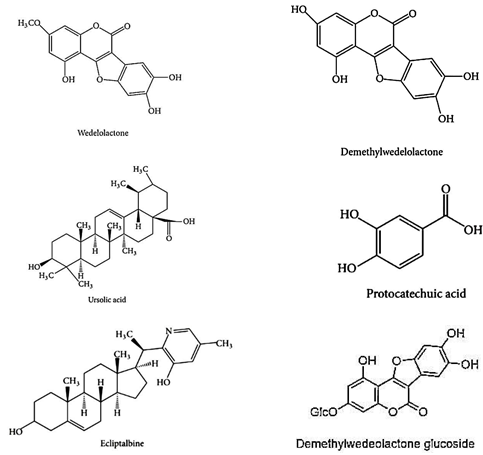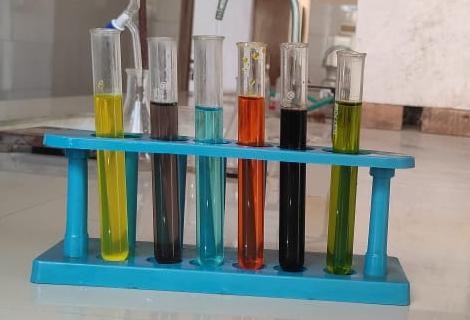Ijraset Journal For Research in Applied Science and Engineering Technology
- Home / Ijraset
- On This Page
- Abstract
- Introduction
- Conclusion
- References
- Copyright
ECLIPTA ALBA: A Review of Pharmacological Activity with Phyto-Constituents
Authors: Anshuman Bajpai, Abhinav Dubey , Pintu Yadav, Avinash Verma, Zainab khan, Anand Kumar, Ashutosh Singh, Dr. Alok Kumar Shukla
DOI Link: https://doi.org/10.22214/ijraset.2025.66586
Certificate: View Certificate
Abstract
Plants are the primary source of food, shelter, and various remedial approaches, they are being in use for treating various kinds of human ailments across the world since the ancient times. The review describes the innumerable herbal medicinal plants named Eclipta alba hassk (Asteraceae) which is commonly known as Bhringraj and false daisy. This plant is known for its extra –ordinary therapeutic properties. It is one of most widely used plant in traditional systems of medicines such as Ayurvedic, Unani, siddha, Homeopathy, Chinese, and folk. Bhringraj (Eclipta prostrate or eclipta alba) is a famous herb known for known for its benefits and usage in hair growth and liver disorders. This article highlights chief constituents, extraction procedure, phytochemistry, pharmacological activities, phytochemical screening& toxicity studies of Eclipta alba. Each part of this medicinal plant contains many important phytochemical constituents such as flavonoids, steroids, saponins. E. alba exhibites many other important biological properties such as anticancer, antibacterial, antiviral, antistress, and immunomodulatory. It increases the production of bile from the liver, improves liver functions, reduce constipation and correct digestion and enhance metabolism.
Introduction
I. INTRODUCTION
The herb Bhringraj is native of India, China, Taiwan, Philippines, Japan and Indonesia. Eclipta alba has long been used in ayurveda to treat different type of disease. It has four varieties. These are based on its color of flower. These are yellow, white, blue and red. It is an erect or prostrate, branched (occasionally rooting at nodes) annual herb up to 30-40cm height. Leaves of this plant are 2.5-7.5cm long. On a long stalk, it has small white daisy like flowers and short, prostrate or circular, brown stem [3]. Stem is cylindrical or flat, rough due to appressed white hairs, nodes distinct and greenish occasionally brownish [2]. The roots, seeds, seed oil, leaves and whole plant is used as herb.
A. Biological Source
Bhringraj is also called false daisy in English. The botanical name of Bhringraj is Eclipta alba Family-Asteraceae.[1]
B. Geographical Distribution
It is found as a weed in tropical and subtropical regions of the world such as South America, AsiaS, and Africa at an altitude of up to 2000 m. It is found throughout India, China, Thailand, and Brazil, Taiwan, Indonesia, Japan, the Philippines, Bangladesh, and United States. In India, it is mainly found in states Assam, Bihar, Uttar Pradesh, and Manipur.
C. Vernacular Names [2]
English - False Daisy
Sanskrit - Keshraj, Kesharjuna, Bhringraj
Hindi- Bhangra, Bhangraya
Gujarati- Bhangro
Telgu- Galgara M
arathi- Maka
Bengali- Kesuria
Latin - Eclipta Alba
Kannada - Garagada

Fig. 1- Bringraj plant Fig. 2-Bringraj flower
D. Taxonomy [2]
Table no 1-Taxonocal classification
|
Kingdom |
Plantae |
|
Subkingdom |
Viridaeplantae |
|
Division |
Tracheophyta |
|
Class |
Magnoliopsida |
|
Order |
Asterales |
|
Family |
Asteraceae |
|
Genus |
Eclipta l. |
|
Species |
Eclipta alba |
E. Ayurvedic Formulations of Bhringraj
The different Ayurvedic Formulation of Bhjringraj are well mentioned below-[1]
- Bhringraj Churana
- Bhringraja Ghrit
- Bhringraja Oil
- Bhringrajadi Churna
- Bhringrajasasv
- Narasimha Rasayanam
- Neelibhringadi Oil
F. Extraction Procedure of Eclipta alba
First of all, collect plant from garden. Eclipta alba whole plant was cut into small pieces by knife. 250 g of dried small pieces Eclipta alba (whole plant) was taken in two separate 2000 ml conical flask and added 1000 ml of methanol and 1000 ml of petroleum ether. It was kept for 72 hrs in air tight condition at 25 to 30 °C temperature. After that, it was filtrated by normal filter paper. Filtrate was kept in a 1000 ml beaker. After filtration; the filtrate was concentrated by rotary evaporator at 40 to 45°C temperature and other ambient condition. The percentage yield of extraction was 1.16% w/w. The extract was stored in glass vials in air tight condition at room temperature with proper label.[6]
G. Phyto-chemicals
Table no 2 -Phytochemical screening -
|
S. No. |
Parts |
Chemical Constituents [3] |
|
1 |
Leaves |
Wedelolactone Des methyl wedelolactone Des methyl wedelolactone 7- glucoside Stigmasterol |
|
2 |
Roots |
Hentriacontanol Heptacosanol Stigmasterol Ecliptal Eclalbatin |
|
3 |
Aerial Parts |
Beta-amyrin &luteolin-7-0- glucoside Apigenin Cinnaroside Sulphur compounds Eclalba saponins |
|
4 |
Stems |
Wedelolactone Wedelic Acid L-terthienyl methanol luteolin. |
|
5 |
Seeds |
Sterols Ecliptalbine |
|
6 |
Whole Plant |
Resin Ecliptine Reducing Sugar Nicotine Stigmasterol Triterpene Saponin Eclalbatin Ursolic Acid |
Table no 3 Highlight of secondary metabolites present
|
Alkaloids |
Ecliptine Ecliptamine Des methyl wedelolactone Verazine |
|
Glycosides |
Wedewloside Luteolin Apigenin Kaempferol |
|
Flavonoids |
Eclalbatin Hyperoside Rutin Quercetin |
|
Carbohydrate |
Inuline Starch Cellulose Pectine |
|
Saponins |
Eclalba saponin A Eclalba saponin B Wedela saponin A Wedela saponin B |
|
Tannins |
Gallocatechin Epicatechin Ellagic Acid Chebulagic Acid |
|
Phytosterols |
Stigmasterol Ecliptasterol Spinasterol Avenasterol |
|
Protein and Amino acids |
Aspartic Acid Glutamic Acid Leucine Eclalbanin |


Fig. 3 Chemical structure of constituents of Eclipta alba
II. PHYTOCHEMICAL SCREENING OF HERBAL EXTRACT
A. Detection of Phytosterols
Libermann-Burchard Test:
- Dissolve 10 mg of the extract in 1 ml chloroform.
- Add 1 ml acetic anhydride, followed by 2 ml concentrated sulfuric acid.
- A reddish-violet color indicates the presence of steroids.
- Salkowski Test:
- Dissolve 10 mg of the extract in 1 ml chloroform.
- Add 1 ml concentrated sulfuric acid.
- A reddish-blue color in the chloroform layer and green fluorescence in the acid layer confirm the presence of steroids.
B. Detection of Triterpenoids
Nollar’s Test:
- In a test tube, mix 2 ml of 0.01% anhydrous stannous chloride in a thionyl chloride solution with the test solution.
- Formation of a purple color that transitions to deep red after a few minutes indicates the presence of triterpenoids.
C. Detection of Flavonoids
Shinoda Test:
- Add magnesium turnings to the extract, followed by concentrated hydrochloric acid.
- The production of a red color confirms the presence of flavonoids.
D. Detection of Alkaloids
Mayer’s Test:
- Mix 1.2 ml of extract with 0.2 ml dilute hydrochloric acid and 0.1 ml Mayer’s reagent.
- A yellowish-buff precipitate indicates the presence of alkaloids.
Dragendorff’s Test:
- Add 0.1 ml dilute hydrochloric acid and 0.1 ml Dragendorff’s reagent to 2 ml of the extract solution.
- The formation of an orange-brown precipitate suggests alkaloid presence.
Biuret Test:
- Mix 1 ml of 40% NaOH with 2 drops of 1% copper sulfate and add to the extract.
- A violet color indicates the presence of proteins.
E. Detection of Proteins and Amino Acids
Ninhydrin Test:
- Treat the extract solution with ninhydrin (tri-keto hydrindene hydrate) at a pH of 4–8.
- Development of a purple color indicates the presence of amino acids.
F. Detection of De-oxy Sugars
Keller-Kiliani Test:
- Add 10 ml of 70% ethanol to 1 g of the sample and boil for 2–3 minutes.
- Filter and add 5 ml distilled water and 0.5 ml strong lead acetate solution to 5 ml of the filtrate.
- Filter again, then add 5 ml chloroform to the filtrate. Evaporate the chloroform residue gently and cool.
- Add 3 ml glacial acetic acid and 2 drops of 5% ferric chloride, then layer the solution over 2 ml concentrated sulfuric acid.
- A reddish-brown color transitioning to bluish-green confirms the presence of de-oxy sugars.
G. Detection of Reducing Sugars
Fehling’s Test:
- Mix 5 ml extract solution with 5 ml Fehling’s solution and boil for 5 minutes.
- The formation of a brick-red precipitate indicates reducing sugars.
H. Detection of Glycosides
Borntrager’s Test:
- Add a few ml of dilute sulfuric acid to the test solution, boil, filter, and extract the filtrate with ether or chloroform.
- Separate the organic layer and add ammonia. A pink-red color in the organic layer confirms glycosides.
- Keller-Kiliani Test:
- Dissolve the sample in acetic acid with a trace of ferric chloride and layer over concentrated sulfuric acid.
- A reddish-brown color at the junction, gradually turning blue, indicates glycosides.
I. Detection of Phenolic Compounds and Tannins
Ferric Chloride Test:
- Mix 5 ml extract solution with 1 ml 5% ferric chloride.
- Greenish-black coloration indicates tannins.
- Potassium Dichromate Test:
- Treat 5 ml extract with 1 ml 10% potassium dichromate solution.
- A yellowish-brown precipitate confirms tannins.
J. Detection of Saponins
Foam Test:
- Dilute 1 ml extract solution with distilled water to 20 ml and shake in a graduated cylinder for 15 minutes.
- Stable foam formation indicates saponins.
Potassium Dichromate Test:
- Treat 1 ml extract with 1% lead acetate solution.
- A white precipitate confirms the presence of saponins.
III. RESULT
Phytochemical screening of the Aqueous extract of Herbal Extract showed presence of different type of Phyto-constituents as depicted below-
Table no 4 – Phytochemicals test
|
1 |
Phytosterols |
+ |
|
2 |
Triterpenoids |
- |
|
3 |
Flavonoids |
+ |
|
4 |
Alkaloids |
+ |
|
5 |
Protein and amino acids |
+ |
|
6 |
Carbohydrates |
+ |
|
7 |
Glycosides |
+ |
|
8 |
Phenolic compounds and Tannins |
+ |
|
9 |
Saponins |
+ |
(“+” Indicates positive; “-” indicates negative)[5]
Fig. 5 Phytochemical test
IV. PHARMACOLOGICAL ACTIVITY
A. Biological Activities of Eclipta Alba
1) Antimicrobial Activity
- General Uses: Eclipta alba is traditionally used for cirrhosis and infectious diseases. It is believed to rejuvenate hair, teeth, bones, memory, sight, and hearing. The plant exhibits anti-fungal and insecticidal properties and has shown significant anti-hepatitis B virus activity.
- Specific Effects: Root extracts demonstrated antibacterial activity against Staphylococcus aureus and Escherichia coli. Various solvent extracts (petroleum ether, benzene, chloroform, acetone, methanol, aqueous) were effective against clinical isolates from oral cancer cases, including bacteria such as Pseudomonas aeruginosa and fungi like Candida albicans. Ethanol and ethyl acetate extracts exhibited activity against several pathogens with MIC values ranging from 4.5 to 90 µL/mL.
2) Anti-inflammatory Activity
- Phytochemicals: Compounds such as wedelolactone, eclalbatin, ursolic acid, and apigenin contribute to anti-inflammatory effects.
- Ethanolic Extract Studies: These extracts demonstrated anti-inflammatory activity in models involving carrageenan-induced paw edema and cotton pellet-induced granuloma tests.
3) Hepatoprotective Activity
- Research Findings: Alcoholic extracts showed protective effects against experimental liver damage in rats and mice, restoring functional markers, lysosomal enzymes, and counteracting CCl4-induced hepatic microsomal enzyme inhibition.
4) Immunomodulatory Activity
- Compounds: Methanolic extracts, wedelolactone, and dimethyl wedelolactone demonstrated immune-modulating effects, with potent trypsin inhibition observed in vitro (IC50 ~ 2.9–3.0 µg/ml).
5) Anticancer Activity
- EAC Model Studies: Methanolic extracts were effective against Ehrlich Ascites Carcinoma in mice, improving life span and restoring hematological parameters.
- Phytoestrogens and Saponins: Coumestans and dasyscyphin-C showed chemo-preventive activity against breast and prostate cancer, with cytotoxic effects on HeLa and Vero cell lines.
6) Hair Growth Activity
- Traditional Use: Widely used in Ayurvedic hair oils for promoting hair growth.
- Experimental Studies: Petroleum ether and ethanolic extracts in cream formulations improved hair growth in albino rats, outperforming minoxidil 2% solution.
7) Antivenom Activity
- Inhibitory Effects: Extracts inhibited phospholipase A2 activity in Crotalus durissus terrificus venom, attributed to coumestans like wedelolactone.
8) Antiulcer Activity
Ethanolic Extracts: Effective in reducing ulcerative lesions in rats, with significant reductions in gastric volume, acid output, and lipid peroxidation. Activity was comparable to rabeprazole, a proton pump inhibitor.
9) Antioxidant Activity
- In Vivo Studies: Oral administration in rats reduced serum hydroxyl radicals and lipid peroxides.
- Assays: Hexane, ethyl acetate, ethanol, and water extracts exhibited concentration-dependent antioxidant activity, with ethanolic extract (500 µg/mL) showing 77.62% activity, comparable to α-tocopherol.
Conclusion
The herb has multiple medicinal properties for humans and animals and also availed some cosmetics properties. Eclipta alba offers a remarkable activity for curing of many diseases. It has a wide range of chemical constituents. Clinical investigations have been done on pharmacological activities like hepatotoxicity, proliferative, diabetic, hypolipidemic etc. It has a greater potential to inhibit the growth of the bacteria and fungus. Further investigation of the plant can increase the isolation of the newer molecules which will be helpful for the study of the pharmacological activities and to discover from the plant thus preventing the human and the economic losses in the environment.
References
[1] Sidh, Dr. Vikram, and Sharma, Dr. Omprakash. \"Medicinal Use of Bhringraja (Eclipta Alba Hassk.): A Review Article.\" World Journal of Pharmaceutical and Medical Research 2455-3301 WJPMR. [2] Alam, M.K., Tuli, K.A., Khan, M.K.I., and Hossain, M.S. \"Bhringraj (Eclipta Prostrata L.): Botanical Nomenclature, Characteristics, Medicinal and Herbal Activities.\" World Journal of Pharmaceutical and Life Sciences 2454-2229 WJPLS. [3] Mukhopadhyay, Goutam, Kundu, Shymodip, Sarkar, Pintu, Sengupta, Riyanka, and Kumar, Chandan. \"A Review on Physicochemical & Pharmacological Activity of Eclipta Alba.\" The Pharma Innovation Journal 7, no. 9 (2018): 78–83. [4] Umesh, A., and Kumudhavalli, M.V. \"A Review on Phytopharmacological Significance of Eclipta Alba.\" International Journal of Research in Pharmacy and Chemistry 10, no. 1 (2020): 63–70. [5] Mukhopadhyay, Gautam, Kundu, Shymodip, Sarkar, Argha, Sarkar, Pintu, and Kumar, Chandan. \"A Review on Physicochemical & Pharmacological Activity of Eclipta Alba.\" The Pharma Innovation Journal 7, no. 9 (2018): 78–83. [6] Mukhopadhyay, G., Kundu, Shymodip, Sarkar, Argha, Sarkar, Pintu, Sengupta, Riyanka, and Kumar, Chandan. \"A Review on Physicochemical & Pharmacological Activity of Eclipta Alba.\" The Pharma Innovation Journal 7, no. 9 (2018): 78–83. [7] Jayatirtha, M.G., and Mishra, S.H. \"Preliminary Immunomodulatory Activities of Methanolic Extracts of Eclipta Alba and Centella Asiatica.\" Journal of Phytomedicine 11 (2004): 361–365. [8] Syed, S.D., Muddarachappa, K.A., D’souza, P., Agarwal, A., and Venkataraman, B.V. \"Trypsin Inhibitory Effect of Wedelolactone and Demethylwedelolactone.\" Phytotherapy Research 17 (2003): 420–421. [9] Khanna, K. \"Anticancer-Cytotoxic Activity of Saponins Isolated from the Leaves of Gymnema Sylvestre and Eclipta Alba on HeLa Cells.\" International Journal of Green Pharmacy 1 (2008): 227–229. [10] Khin, M.M., Nyunt, N.N., and Khin, M.T. \"The Protective Effect of Eclipta Alba on Carbon Tetrachloride-Induced Acute Liver Damage.\" Toxicology and Applied Pharmacology 45 (1978): 723–728. [11] Singh, B., Saxena, A.K., Chandan, B.K., Agarwal, G., and Anand, K.K. \"In Vivo Hepatoprotective Activity of Active Fraction from Ethanolic Extract of Eclipta Alba.\" Indian Journal of Physiology and Pharmacology 45 (2001): 435–441. [12] Thakur, V.D., and Mengi, S.A. \"Neuropharmacological Profile of Eclipta Alba (Linn.) Hassk.\" Journal of Ethnopharmacology 102 (2005): 23–31. [13] Roy, R.K., Mayank, Thakur, and Dixit, V.K. \"Hair Growth Promoting Activity of Eclipta Alba in Male Albino Rats.\" Archives of Dermatological Research 300 (2008): 357–364. [14] Thorat, Rupali, Jadhav, Varsha, Kadam, Vilasrao, Sathe, Ninad, Save, Ashwini, and Ghorpade, Vikas. \"Evaluation of a Herbal Hair Oil in Reducing Hair Fall in Human Volunteers.\" 2009, 6: 974–979. [15] Karthikumar, S., Vigneswari, K., and Jegatheesan, K. \"Screening of Antibacterial and Antioxidant Activities of Leaves of Eclipta Prostrata (L).\" Scientific Research and Essays 2, no. 4 (2007): 101–104. [16] Rao, Bhaskar, D., Ravi Kiran, Ch., Madhavi, Y., Koteshwara Rao, P., and Raghava Rao, T. \"Evaluation of Antioxidant Potential of Clitoria Ternatea L. and Eclipta Prostrata L.\" Indian Journal of Biochemistry and Biophysics 46 (2009): 247–252. [17] Karthikumar, S., Vigneswari, K., and Jegatheesan, K. \"Screening of Antibacterial and Antioxidant Activities of Leaves of Eclipta Prostrata (L).\" Scientific Research and Essays 2, no. 4 (2007): 101–104. [18] Panghal, M., Kaushal, V., and Yadav, J.P. \"In Vitro Antimicrobial Activity of Ten Medicinal Plants against Clinical Isolates of Oral Cancer Cases.\" Annals of Clinical Microbiology and Antimicrobials 10 (2011): article 21. [19] Kumar, S.P., Kumar, B.S., Chandana, V.R., Vijaykumar, M., Ojha, S.K., and Bavani, M.E. \"Antisecretory and Antiulcer Activities of Eclipta Alba Linn. in Rats.\" In Proceedings of the 5th World Ayurveda Congress, Oral Presentation, Abstract No. OA01.03, Bhopal, India, December 2012. [20] Banerjee, A., Shrivastava, N., Kothari, A., Padh, H., and Nivsarkar, M. \"Antiulcer Activity of Methanol Extract of Eclipta Alba.\" Indian Journal of Pharmaceutical Sciences 67, no. 2 (2005): 165–168. [21] Diogo, L.C., Fernandes, R.S., Marcussi, S., et al. \"Inhibition of Snake Venoms and Phospholipases A2 by Extracts from Native and Genetically Modified Eclipta Alba: Isolation of Active Coumestans.\" Basic and Clinical Pharmacology and Toxicology 104, no. 4 (2009): 293–299.
Copyright
Copyright © 2025 Anshuman Bajpai, Abhinav Dubey , Pintu Yadav, Avinash Verma, Zainab khan, Anand Kumar, Ashutosh Singh, Dr. Alok Kumar Shukla. This is an open access article distributed under the Creative Commons Attribution License, which permits unrestricted use, distribution, and reproduction in any medium, provided the original work is properly cited.

Download Paper
Paper Id : IJRASET66586
Publish Date : 2025-01-19
ISSN : 2321-9653
Publisher Name : IJRASET
DOI Link : Click Here
 Submit Paper Online
Submit Paper Online


